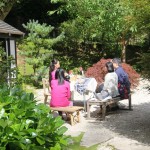Quality Basics 1: Various Plants, Various Qualities
- High on the shaded side of a mountain, a key for good tea horticulture, which in itself is the first key for good production.
- Tea bush let grow old and space created around it for better health. Fenghuang
- Daba, the lovely local tea leaf collection manager stood under her beloved old tea tree in her “backyard”. Such old trees are everywhere in the region. All producing.
- O’oshita ( shaded growth ) in Japanese green tea cultivation. This is a clever method for low land tea cultivation to yield results similar in chemical composition as in high altitude harvests. This tea farm, however, is in Shaoxing, China, and the way they shade the tea plant is more relaxed than their counterparts in Japan. This particular farm produces some of the most popular mass market “high quality” Japanese green tea.
Diversity of the tea plant
Although only a few varieties/subvarieties of the Camellia sinensis species are employed for tea production, there are hundreds of cultivars each possessing unique biological characteristics. In fact, much scientific work is still needed to agree on the botanical classification of many tea bushes that are used in certain regions, particularly where traditional oolongs and puers are produced.
The plants that we make tea from can be giant trees over 25 meters tall, some are creeping bushes never over 30 cm, yet most are bushes which maximum natural heights are around 3~5 m. The tea bushes in most pictures that the consumers are shown are trimmed hedges which height is kept below the human chest for efficient leaf gathering. This is a modern way of tea growing, but there are in practice other traditional forms of horticulture with priorities other than efficiency.
Adapting to different growing environments
Tea trees/bushes grow in dramatically different geographic environments. Some fields are in the flatland, some on rolling hills, and others on terraced steep slopes in deep mountains. These can be in the tropical valleys of Assam inland of India, or in the misty mountains of maritime climate Taiwan, or on the gentle low slopes of Uji in temperate Japan, or on the steppes in the steep mountains of Huangshan in the continental weather of the province of Anhui in China. Whatever the altitude, in temperate or tropical zones, on sandy soil or mossy peat, the plant strives on moisture, but not heavy rainfalls. The same cultivar can even become two bushes of different characters when grown in two different micro-climates and soil environments. The leaves these two bushes yield may result in two products that do not taste alike.
Plant propagation basing on production needs
Tea is a flowering plant. It naturally forms offsprings of different characteristics through sexual propagation, although most new variations may not be ideal for tea production. Hybrids are also made by human through traditional processes such as grafting or artificial pollination. All major tea production regions in the world develop cultivars best suited for their production needs. Very few maintain the use of indigenous plants or their natural offsprings, with the exception of some Puer regions, some oolong regions, and scattered green tea regions in China.
A lot of times cultivars are used or developed for productivity reasons, such as budding season, growth rate, resilience against pests, etc. It is also a common practice for breeders to cross cultivars from various regions for specific aroma or taste. For example, a cultivar named “Sofu” was developed in Japan in 2004 for a more distinctive aroma with a quarter of its ancestry from Manipur (Assam, India) and the rest from local cultivars (1). In Zhejinag, China, the production of the famous green tea “Longjing” (Dragon Well), plucks from the cultivar “Longjing Chang-ye” would make a different taste style than those made from the cultivar “Longjing #43”, even going through exactly the same process. These two are only two of the most common cultivars used almost exclusively for Longjing production.
Today, China utilizes by far the most diverse and numerous cultivars for production both within and beyond the two popular varieties of Camellia sinensis. Although I cannot find any reliable and detail statistics, there must be over a few hundreds just from my personal encounter. In the province of Fujian alone, there are 3 regions each of tens of local breeds and aggressively introducing new ones almost every year. In the ancient Phoenix oolong region (Fenghuang) in Guangdong, in any tiny tea farm of even a single acre, the farmer can be keeping clones from 10 to 15 different indigenous cultivars; some individual trees can be over a few hundred years old. In Yunnan, where other subvarieties of Camellia sinensis are employed for Puer production, the uniqueness and authentic ancestry of the plant is a key asset some of the producers boost themselves of.
Another most important element that gives a tea its characteristic taste is the kind of production method that it goes through and the quality with which it is executed »read on















